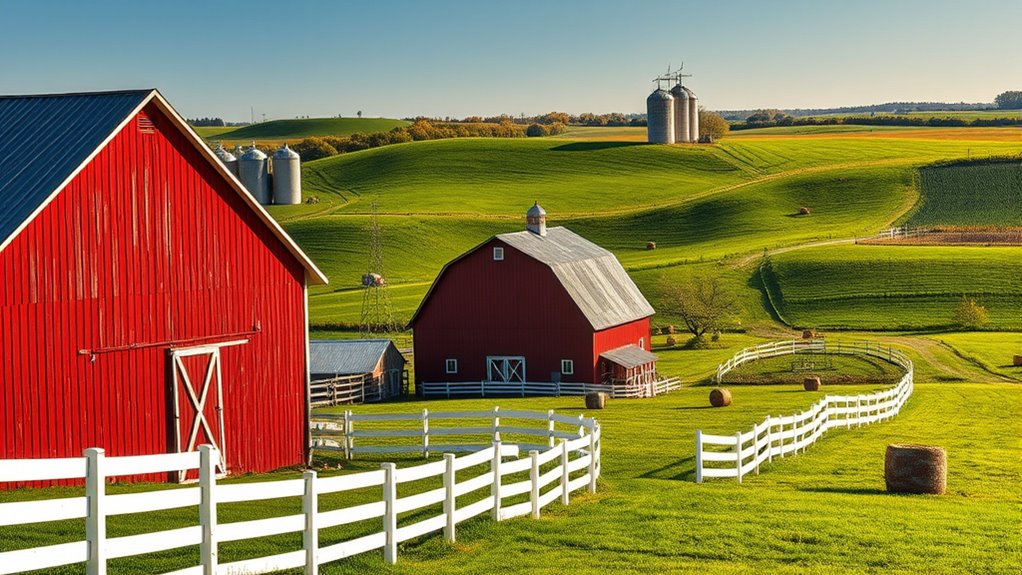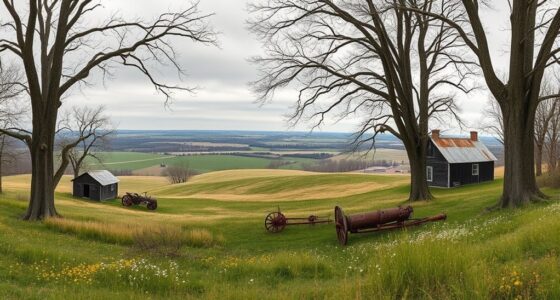Red barns and white fences are iconic symbols of Midwest farm aesthetics, reflecting the region’s hardworking spirit and rural traditions. The vibrant red barns protect the wooden structures, while the white fences mark boundaries and add contrast to the land’s earthy tones. These elements showcase practicality, durability, and simplicity, embodying the region’s values and timeless charm. To discover more about their cultural significance and how they shape the landscape, explore further insights below.
Key Takeaways
- Red barns symbolize Midwest resilience, heritage, and rural traditions, serving as visual icons of perseverance and community spirit.
- White fences define land boundaries, add aesthetic contrast, and emphasize durability in rural farm settings.
- Both structures highlight practical design, weather resistance, and simplicity, reflecting regional values of functionality and honest beauty.
- The scene evokes nostalgia, connecting past generations to present rural life through enduring symbols of land and hard work.
- These elements embody regional identity, showcasing timeless, rustic charm rooted in practicality and traditional farm aesthetics.

Midwest farm aesthetics embody a timeless charm rooted in practicality and natural beauty. When you think of red barns and white fences, you’re visualizing more than just structures; you’re picturing a way of life that’s deeply connected to rural traditions. These iconic features have become symbols of the Midwest’s hardworking spirit and enduring heritage. The red barn, with its weathered wooden siding and simple design, reflects the rustic charm that has stood the test of time. You can imagine it nestled among rolling fields, serving as a backdrop for generations of farming stories. Its vibrant color isn’t just for looks; it’s a practical choice that helps protect the wood from the elements. Paired with white fences, the scene becomes a picture of harmony and order. The fences aren’t just boundary markers—they’re part of the landscape, echoing the rural traditions that have shaped the region.
As you drive through the Midwest, the sight of these white fences stretching across open land instantly evokes a sense of nostalgia. They define the boundaries of pastures and gardens while adding a crisp contrast to the earthy tones of the land. These fences have a functional purpose, keeping livestock safe and crops contained, but they also serve as a visual reminder of the simplicity and honesty of rural life. The combination of red barns and white fences isn’t accidental; it’s a deliberate aesthetic rooted in practicality. Both elements are designed to withstand the weather and serve their purpose over decades, embodying the durability and resilience that rural traditions emphasize. When you observe this scene, you’re witnessing more than just a farm layout—you’re seeing a reflection of values that prioritize hard work, resourcefulness, and respect for the land.
The Midwest’s farm aesthetics don’t rely on flashy embellishments but instead celebrate authenticity. The rustic charm of a red barn paired with pristine white fences captures the essence of rural life, where utility and beauty go hand in hand. These structures remind you that simplicity often holds the most beauty, and tradition provides a sense of continuity that links past generations to the present. Whether you’re standing on a quiet country road or admiring a postcard-perfect farm scene, it’s clear that red barns and white fences are more than just visual staples—they’re enduring symbols of the Midwest’s rural soul. They tell stories of perseverance, community, and a deep-rooted connection to the land that continues to inspire and define the region’s unique farm aesthetics. Additionally, these elements showcase the timeless design that emphasizes durability and functionality, reflecting the region’s appreciation for practicality and tradition.
Frequently Asked Questions
What Is the History Behind the Red Barns and White Fences Tradition?
You might wonder about the history behind red barns and white fences. Red barns became popular because barn symbolism shows red as a practical and durable color, thanks to iron-rich paint that protected wood. White fences are often made through fence construction techniques using whitewashed wood, symbolizing cleanliness and tradition. Together, they create a timeless rural aesthetic, blending functionality with cultural significance rooted in farm history.
How Do Climate Changes Affect Farm Aesthetics in the Midwest?
Imagine your farm as a sturdy ship facing stormy seas; climate change tests its resilience. Rising temperatures and unpredictable weather threaten your traditional aesthetic, forcing you to adapt. Embracing climate adaptation helps preserve your farm’s beauty, ensuring aesthetic resilience amid changing conditions. By integrating sustainable practices, you maintain that timeless charm of red barns and white fences, proving your farm’s resilience against nature’s shifting tides.
Are There Regional Variations in Barn and Fence Styles Across the Midwest?
Yes, regional architecture influences barn and fence styles across the Midwest. You’ll notice that in the Great Lakes area, barns often feature timber frame construction, while in the plains, you’ll see more metal siding. Fencing materials also vary; wood fences dominate in rural areas, but barbed wire is common on ranches. These regional differences reflect local climate, available materials, and farming traditions, giving each area a unique aesthetic.
What Are Sustainable Practices for Maintaining Traditional Farm Aesthetics?
Imagine a sunny morning on your farm, where you maintain traditional aesthetics sustainably. You can do this by embracing organic farming methods, enriching the soil naturally and reducing chemical runoff. Installing solar-powered barns minimizes energy use and preserves the rustic charm. Regularly caring for white fences with eco-friendly paints and using local, sustainable materials helps keep your farm’s classic look alive while protecting the environment.
How Do Modern Farms Incorporate Historic Farm Aesthetics Into Their Design?
You incorporate historic farm aesthetics into your modern farm design by blending heritage preservation with design innovation. You select traditional architectural elements, like red barns and white fences, and update them with sustainable materials and modern construction techniques. By balancing authenticity with functionality, you create a farm that honors its roots while meeting contemporary needs. This approach guarantees your farm retains its charming character and cultural significance, fostering a sense of legacy and innovation.
Conclusion
As you take in the timeless charm of red barns and white fences, you realize they quietly whisper stories of tradition and perseverance. These simple elements gently remind us of the enduring beauty in authenticity and hard work, even when times change. Embrace this subtle grace, for it’s a gentle nudge to cherish what’s genuine and rooted. In appreciating these humble symbols, you find a quiet reassurance that some things, like the Midwest’s heart, remain beautifully constant.










